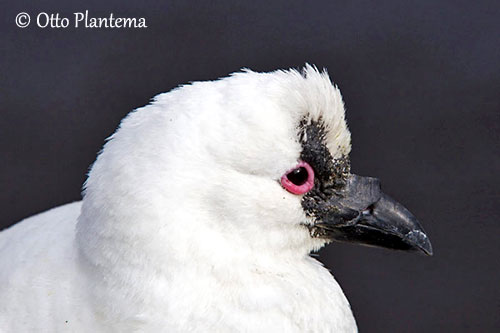
Two cards in this family:
Black-faced Sheathbill - Chionis minor - Petit Chionis
Snowy Sheathbill - Chionis alba - Chionis blanc
Photographers:
John Anderson
John Anderson Photo Galleries
Eduardo Andrés Jordan
MIS AVES – AVES DE ARGENTINA
Otto Plantema
Trips around the world
Text by Nicole Bouglouan
Sources:
HANDBOOK OF THE BIRDS OF THE WORLD Vol 3 by Josep del Hoyo-Andrew Elliott-Jordi Sargatal - Lynx Edicions - ISBN : 8487334202
L’ENCYCLOPEDIE MONDIALE DES OISEAUX - Dr Christopher M. Perrins - BORDAS - ISBN: 2040185607
BirdLife International (BirdLife International)
Department of Sustainability, Environment, Water, Population and Communities
Welcome to the UVic Seabird & Murrelet Research Group
Australian Antarctic Division: Leading Australia's Antarctic Program
Wikipedia, the free encyclopaedia
CHIONIDAE FAMILY
Sheathbills
Sheathbills are the only birds breeding entirely within Antarctic and sub Antarctic regions. This environment where seabirds are dominant, involved predator and scavenger behaviour for these land birds. They depend for food on seabird and penguin’s colonies, and are often seen around carcasses along with petrels and skuas.
The Chionidae family includes two species of the same genus “Chionis”. They have slightly different appearance and non-overlapping ranges. However, they have very similar behaviour.
The Snowy Sheathbill or Pale-faced Chionis (Chionis alba) breeds on the Antarctic Peninsula and sub Antarctic islands of the Scotia Arc. During winter, numerous birds migrate to Patagonia, Tierra del Fuego and Falkland Islands.
The Black-faced Sheathbill (Chionis minor) is resident all year round on four widely separated archipelagos close to the Antarctic Convergence in the southern Indian Ocean. This species has four subspecies, according to each island group.
These sturdy birds have strong legs and feet, well adapted to their ground habits. As they do not have webbed feet, they are not adapted for aquatic behaviour. On the ground, they have chicken-like gait but they can run rapidly.
The white plumage includes a thick grey layer of underdown. On the head, the characteristic bill sheath and facial caruncles make the difference between the two species, with greenish sheath and pink caruncles in the Snowy Sheathbill, and black facial pattern in the Black-faced Sheathbill.

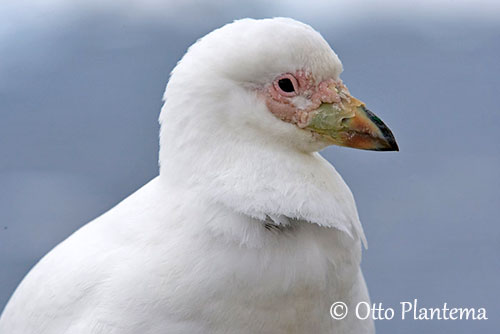
The adults develop blunts, black carpal spurs, sometimes used in the rare and brief fights between opponents. The stout bill is used for ripping flesh, pecking open eggs, probing boggy vegetation to reach invertebrates, and generally for feeding.
Both sexes are similar in appearance, but the male is usually larger and heavier than the female, with more conspicuous bills and sheaths. The moult occurs after the breeding season and is fairly protracted. The replacement of the primaries takes 70 days.
Sheathbills perform strong, direct flight, with continuous wingbeats and occasional glides. The Snowy Sheathbill has considerable flying capacity, allowing the species to migrate over hundreds of kilometres above the open sea, without alighting on the water.
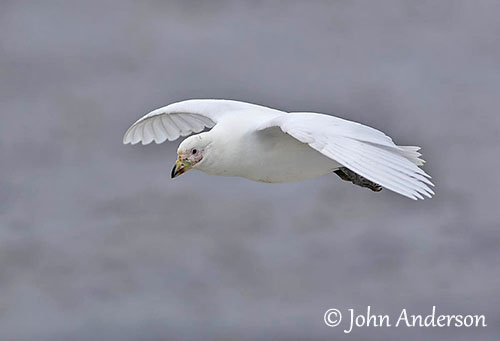
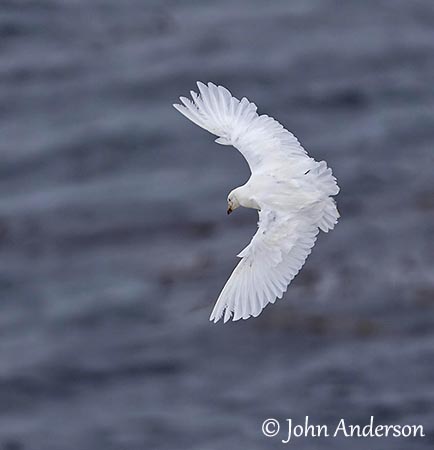
Sheathbills frequent the coastal regions of sub Antarctic areas. Their breeding territories are often close to penguin colonies and even include part of it. Their breeding cycle is closely related to that of penguins which provide food to the sheathbills during the nesting period, and protection against predators.
They forage along the shoreline on rocky and sandy beaches where they can find invertebrates among the rotting piles of algae. They may wander about one kilometre inland in meadows, bogs and tussock grass where they find terrestrial insects and earthworms.
They often forage among marine mammals, feeding on faeces, placentae, blood and milk from seals. Within penguin colonies, they take small chicks and eggs, but also steal food from adults feeding their chicks. They are very opportunistic feeders, and take advantage of any food item found on the ground or stolen from other seabird.
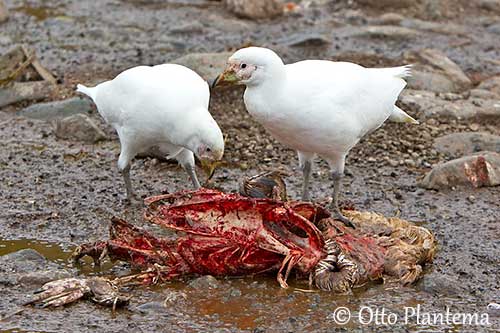


Sheathbills strongly defend their territories. Courtship displays are reported, such as “Bowing Ceremonies” during which both mates bow their heads up and down while calling “kek, kek, kek, kek…”
These displays are used as response to intruders or disturbance too. Disputes between neighbours are rare, but they involve ritual behaviour, often ending peacefully. However, fights involve pecking and grabbing the rival with the bill, while performing strong battering with the wings and carpal spurs. The opponents face each other in upright posture with slightly open wings. But these encounters last just a few seconds.

During the breeding season, Sheathbills call to establish the territory. The nest is usually hidden in crevices or small caves, or even abandoned petrel’s burrows, usually within the feeding territory. This is a cup placed at top of piles of smelling, untidy algae, tussock grass, feathers and debris. The female lays 2-3 eggs and both sexes incubate during 28-32 days. The nidiculous chicks are covered with brown down. Parents feed them by the bill but they do not regurgitate. The chicks fledge 50-60 days after hatching.
The main chick predators are the skuas, and parents chase them while calling loudly.

Sheathbills are widespread and their populations appear stable. In spite of some decline due to invasive species such as feral cats, these species are not currently affected by humans, and even may benefit from having extra sources of food in harbours and human settlements.
Both Snowy Sheathbill and Black-faced Sheathbill are not currently threatened, and are evaluated as Least Concern.
